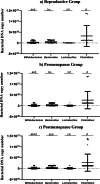The correlation of the fecal microbiome with the biochemical profile during menopause: a Brazilian cohort study
- PMID: 36474222
- PMCID: PMC9724392
- DOI: 10.1186/s12905-022-02063-8
The correlation of the fecal microbiome with the biochemical profile during menopause: a Brazilian cohort study
Abstract
Background: Hormonal, biochemical, and metabolic changes after menopause may alter the quality of life of women, leading to vasomotor, psychological, and genitourinary symptoms, and changes in their gut microbiota, which regulates estrogen levels through the estroboloma. Fecal samples were used to investigate the changes in the gut microbiota during aging and hormonal changes in women. A balanced gut microbiota has been associated with health or disease conditions and remains poorly understood after menopause. This study identified the fecal microbiota, and their association with biochemical and hormonal parameters of a cohort of women in the climacteric in the city of Ouro Preto-MG, Brazil.
Methods: A total of 102 women aged 40 to 65 years old were recruited and distributed into three groups according to the STRAW criteria for reproductive stage: reproductive (n = 18), premenopausal (n = 26), and postmenopausal (n = 58). Blood samples were collected to measure their serum biochemical and hormone levels, and the participants answered a questionnaire. The gut microbiota was analyzed from fecal samples by qPCR using the genera Bifidobacterium, Bacteroides, Lactobacillus, and Clostridium.
Results: The following parameters showed differences among the groups: total cholesterol, triglycerides, VLDL, ApoB, urea, calcium, uric acid, and alkaline phosphatase (p < 0.05). qPCR revealed the genus Clostridium to be the most abundant in all three groups. In the reproductive age group, the significant correlations were: Bacteroides with glucose (r = -0.573 p = 0.0129), and SDHEA (r = -0.583 p = 0.0111). For the premenopausal group, they were: Bifidobacteria with total cholesterol (r = 0.396 p = 0.0451), LDL (r = 0.393 p = 0.0468), ApoB (r = 0.411 p = 0.0368); Lactobacillus and calcium (r = 0.443 p = 0.0232), ALP (r = 0.543 p = 0.0041), LPa (r =-0.442 p = 0.02336); and Bacteroides and urea (r =-0.461 p = 0.0176). In the postmenopausal group, they were Bifidobacterium and ALP (r =-0.315 p = 0.0159), Lactobacillus and urea (r =-0.276 p = 0.0356), and Clostridium and beta estradiol (r =-0.355 p = 0.0062).
Conclusion: In conclusion, the hormonal and metabolic changes during menopause in the population studied were accompanied by a significant change in the fecal microbiota, especially of the genus Clostridium.
Keywords: Climacteric; Gut microbiota; Menopause; qPCR; rRNA16S.
© 2022. The Author(s).
Conflict of interest statement
The authors declare that they have no competing interests.
Figures

Similar articles
-
Gut microbiota profile in healthy Indonesians.World J Gastroenterol. 2019 Mar 28;25(12):1478-1491. doi: 10.3748/wjg.v25.i12.1478. World J Gastroenterol. 2019. PMID: 30948911 Free PMC article.
-
Age-dependent association of gut bacteria with coronary atherosclerosis: Tampere Sudden Death Study.PLoS One. 2019 Aug 22;14(8):e0221345. doi: 10.1371/journal.pone.0221345. eCollection 2019. PLoS One. 2019. PMID: 31437200 Free PMC article.
-
Faecal levels of Bifidobacterium and Clostridium coccoides but not plasma lipopolysaccharide are inversely related to insulin and HOMA index in women.Clin Nutr. 2013 Dec;32(6):1017-22. doi: 10.1016/j.clnu.2013.02.008. Epub 2013 Feb 21. Clin Nutr. 2013. PMID: 23538004
-
Association of Vaginal Microbiota With Signs and Symptoms of the Genitourinary Syndrome of Menopause Across Reproductive Stages.J Gerontol A Biol Sci Med Sci. 2021 Aug 13;76(9):1542-1550. doi: 10.1093/gerona/glab120. J Gerontol A Biol Sci Med Sci. 2021. PMID: 33903897 Free PMC article.
-
The protective effect of Lactobacillus and Bifidobacterium as the gut microbiota members against chronic urticaria.Int Immunopharmacol. 2018 Jun;59:168-173. doi: 10.1016/j.intimp.2018.04.007. Epub 2018 Apr 11. Int Immunopharmacol. 2018. PMID: 29655058
Cited by
-
Sex differences in opioid response: a role for the gut microbiome?Front Pharmacol. 2024 Aug 29;15:1455416. doi: 10.3389/fphar.2024.1455416. eCollection 2024. Front Pharmacol. 2024. PMID: 39268474 Free PMC article. Review.
-
Gut microbial beta-glucuronidase: a vital regulator in female estrogen metabolism.Gut Microbes. 2023 Jan-Dec;15(1):2236749. doi: 10.1080/19490976.2023.2236749. Gut Microbes. 2023. PMID: 37559394 Free PMC article. Review.
References
MeSH terms
Substances
LinkOut - more resources
Full Text Sources
Miscellaneous

